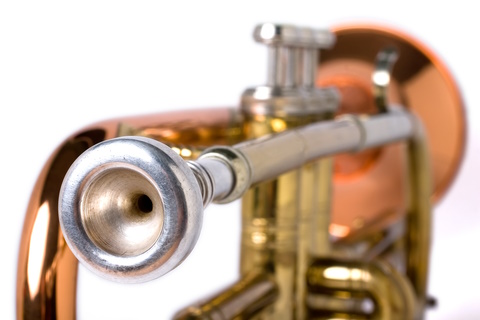Isolating Single Notes
 This information is given from a lip-pursed embouchure perspective, but may be useful for other embouchures. Audio files are based on a 10 hole diatonic harmonica in C major.
This information is given from a lip-pursed embouchure perspective, but may be useful for other embouchures. Audio files are based on a 10 hole diatonic harmonica in C major.
Newcomers to the harmonica can often find it difficult to play accurate single notes. Which is perfectly understandable. Let’s be honest, there really isn’t much to aim at. Plus the concepts of embouchure for accurate intonation and diaphragmatic breathing for tone have yet to be fully explored. Everyone has their own approach to gathering single note skills and some will find success sooner than others. If you are finding this skill elusive and frustrating however, don’t give up. It’s not that you can’t do it, just that you can’t do it yet. Give it time and you will get it. If this is your experience, welcome to the harmonica! Let’s run through a few ideas that may help you in your quest for isolating single notes.
Airtight
For the best tone and accuracy, first we need to eliminate any leakiness. This means placing your lips right round the mouth piece, with the corners of your mouth supportive but not rigid, and lips pushed slightly forward but not stiff. And drop that jaw. Remember also that each hole has dividers either side, so your target area is nearly twice as wide as your eyes might tell you. There is a margin around each hole. Pushing the harmonica into your lips will actually improve your accuracy, airtightness and tone.
Posture
Next you should remember to relax your posture. This includes your shoulders, neck, jaw and tongue. Make sure you’re not slumped or leaning on elbows either, as this compromises deep breathing from your diaphragm. If your cheeks are puffing in and out as you play, this probably means you are not moving warm air from deep down in your abdomen and your tone will suffer as a consequence.
Breath Control
Take a stretch and a yawn, then release a deep sigh as you exhale. This is exactly how to play your first notes – you don’t have to force things. Just exhale and inhale gently from the diaphragm, jaw and tongue relaxed, and resist manipulating the harmonica notes with tongue movement.

Simple as it seems, try applying this to the Major Scale at a slow, measured pace, ensuring that each note receives an extended delivery with equal amounts of draw and blow. Typically we truncate our draw notes, leaving them slightly shorter than our blow notes. Try to keep your inward and outward note distribution symmetrical. The scale is tabbed out in the diagram, hole numbers in orange, blow notes indicated with a black upward arrow and draw notes with a white downward arrow.
The chances are you may still have difficulty isolating single notes. Instead of a clean sound, you’re hearing a ‘busy’ sound (like a car horn) as you catch the holes either side of your target hole. Firstly take consolation in the knowledge that plenty of recording artists have made a fortune playing this way. It shouldn’t prevent you from busking your favourite tunes and having fun. Secondly, you haven’t yet established your embouchure for singling out the notes you want. Be patient. Finally, it’s great that you can detect the difference between a clean and a busy sound; not everybody can. You have good ear muscles! Here’s a ‘busy’ version of the scale above in case you’re unsure of how it might sound..
Blow Notes
To fix things we need to start the process of ear-training. This simply means identifying and isolating your target note by its unique pitch when heard in combination with other notes. Start with 1B (1 blow) where half the job is done for you, and see if you can activate it in isolation. Once you are successful, see if you can carry your breath across to 2B and play this note in isolation.
As you do so, listen carefully to the result and decide whether you can hear 2B alone, or in tandem with 1B below, or 3B and even 4B above. When isolated, 2B will sound clean, simple and pure. When played in combination with a neighbouring note, the result will be edgy and ‘busy’.
To eliminate the intruding note, you need to decide whether it is coming from above or below 2B, or perhaps from both directions. By adjusting each corner of your embouchure (your chops) you can begin to eliminate the intruding note and play 2B in isolation. Everyone’s fine motor skills and muscle tone are unique, so the adjustments required will differ from player to player, but with slight adjustments and some experimentation you can start to play 2B cleanly and consistently.
Before starting work on your draw notes continue to isolate each blow note the length of your harmonica up to 10B. Then try everything with your eyes closed, playing up and down the length of the harmonica. Closing your eyes helps engage with the instrument and focus your hearing on playing each blow note accurately.
Typically you may find difficulty with the higher notes in hole 8B, 9B, and 10B. It may sound obvious, but the holes themselves are no different in size, even if our head tells us they’re smaller. However, the reeds inside are shorter than the reeds in the lower hole numbers and slightly more resistant; they may therefore take a small amount of extra effort to respond, or a slight adjustment of your embouchure. Keep your embouchure fixed and try to control your breath from the abdomen rather than by moving your tongue and mouth shape.
Draw Notes
The commonest problem encountered in playing draw notes is that new players inadvertently slacken their embouchure when breathing in. Consequently the accuracy achieved on the draw notes is suddenly lost. At Harp Surgery we call this the ‘Wallace & Gromit’ effect – all teeth and no lips.

Picture the mouth piece of a trumpet; it’s solid and fixed in shape. Now imagine this mouthpiece is your harmonica embouchure. Whether you exhale or inhale through it, the mouthpiece will always remain fixed and only the air direction will change. As a harmonica player you will need to hold, or fix, your embouchure as you transfer between blow and draw notes, and the muscles in your ‘mask’ may take time to adapt to their new task.
As with our blow notes above, start with 1D (draw 1). Listen out for a clean or busy result and adjust the corner of your embouchure accordingly. Now see if you can move from 1D into 2D, keeping things nice and clean, and adjusting the corners of your embouchure as necessary.
Now, with eyes closed, see if you can travel the length of your harmonica activating each draw note in turn.
Bent Notes
As you embark on your quest for isolating the draw notes on your harmonica, you may encounter some strange results. Although you’re playing a single channel, and you’re keeping your embouchure fixed as instructed, the draw reed seems to produce a ‘wonky’ sound or occasionally no sound at all.
This is probably because you’re moving your tongue as you inhale and/or inadvertently activating control from your vocal tract (gulping rather than sipping). This is all part of the note bending process and, for newcomers, is what usually destabilises the equilibrium of airflow and pressure across the draw reed. In time you will learn to use this to good effect, but for now it’s not what we want. For the same reason, newcomers often have difficulty specifically in activating 2D, for which a separate fix-it tutorial is available on the Harp Surgery website Why Is 2 Draw So Difficult?
Ease off and start the draw process with a small amount of effort and low volume. No need to suction pump the contents out of the harp. A gentle touch should enable you to find the right balance between airflow, mouth shape and reed response. Once you have found your single notes, you can work at strengthening them acoustically, and without bending. Take your time, be patient and, as your embouchure strengthens, so your single note accuracy will also take shape. Top tooting!
